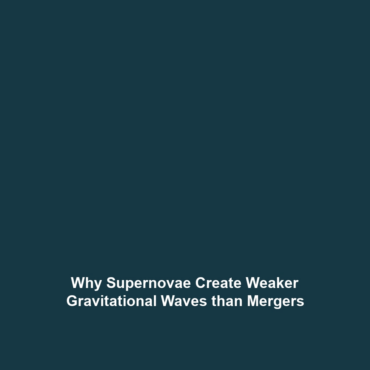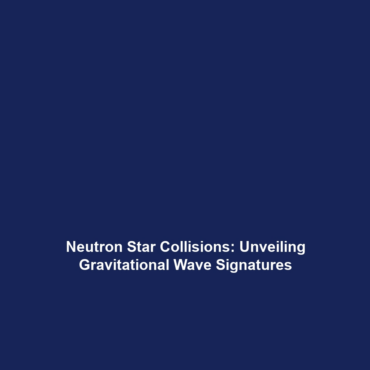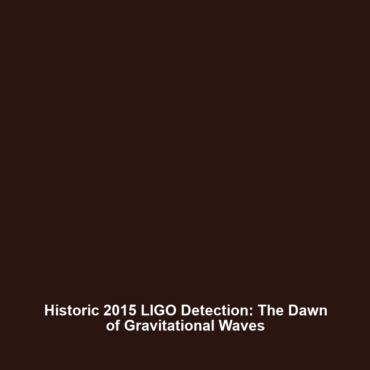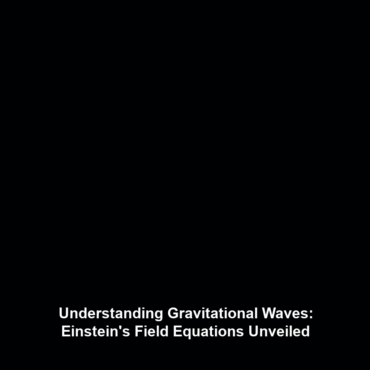Why Supernovae Produce Less Intense Gravitational Waves Compared to Black Hole or Neutron Star Mergers
Introduction
Gravitational waves represent ripples in the fabric of spacetime, generated by some of the universe’s most violent events. Among these,
supernovae, the explosive deaths of stars, provide a fascinating point of study. However, it is observed that supernovae produce
less intense gravitational waves than mergers of black holes or neutron stars. Understanding this discrepancy is significant as it offers
insights into the dynamics of these stellar events and enhances our overall comprehension of gravitational waves. This article explores
the underlying factors that contribute to this difference in intensity.
Key Concepts
Understanding Gravitational Waves
Gravitational waves are generated by accelerating massive objects, emitting energy as ripples in spacetime. The intensity and
frequency of these waves are influenced by the dynamics involved during the event. In this context, three primary categories of events are
considered: supernovae, black hole mergers, and neutron star mergers.
Supernovae and Their Mechanisms
Supernova explosions occur when massive stars exhaust their nuclear fuel and undergo a gravitational collapse. The dynamics involved in a
supernova primarily involve asymmetrical energy distributions, leading to a moderate production of gravitational waves compared to the
extreme environments created during black hole and neutron star mergers.
Black Hole and Neutron Star Mergers
In contrast, mergers of black holes and neutron stars involve two massive objects spiraling towards each other and eventually colliding.
This process releases immense amounts of energy and creates intense gravitational waves detectable by facilities such as LIGO and Virgo.
The significant weight and rapid acceleration of these objects lead to the higher amplitude signals observed.
Applications and Real-World Uses
Understanding why supernovae produce less intense gravitational waves has several applications in astrophysics and observational astronomy.
Some practical uses include:
- Enhancing the calibration of gravitational wave detectors to better distinguish between different cosmic events.
- Improving models of stellar evolution and death, which can influence future research in cosmology.
- Refining methods for calculating the distance and energy output of supernovae, which aids in understanding galaxy formation and evolution.
Current Challenges
Studying the gravitational waves from supernovae presents several challenges:
- Detection Limitations: The weaker signals from supernovae can be obscured by noise in gravitational wave detectors.
- Modeling Events: Accurately simulating the complex physics of supernova explosions remains a difficult endeavor for astrophysicists.
- Event Variability: The different types and energies of supernovae lead to diverse gravitational wave signatures, complicating analysis.
Future Research and Innovations
Future research initiatives aim to enhance our understanding of supernovae and their gravitational waves. Emerging innovations may include:
- Next-Generation Detectors: The development of more sensitive gravitational wave detectors could help capture fainter signals from supernovae.
- Advanced Simulation Tools: Innovations in computational astrophysics will enable better modeling of stellar processes and gravitational wave emissions.
- Interdisciplinary Studies: Collaborations across various fields, such as nuclear physics and astrophysics, will provide deeper insights into supernova phenomena.
Conclusion
In summary, the variability in the intensity of gravitational waves produced by supernovae compared to black hole and neutron star mergers points
to fundamental differences in their underlying mechanisms. Understanding these distinctions enriches our knowledge of astrophysics and
gravitational waves. Continued advances in observational technology and astrophysical modeling hold promise for future breakthroughs
in this captivating field. For further reading, explore our articles on black hole mergers and neutron star mergers.



